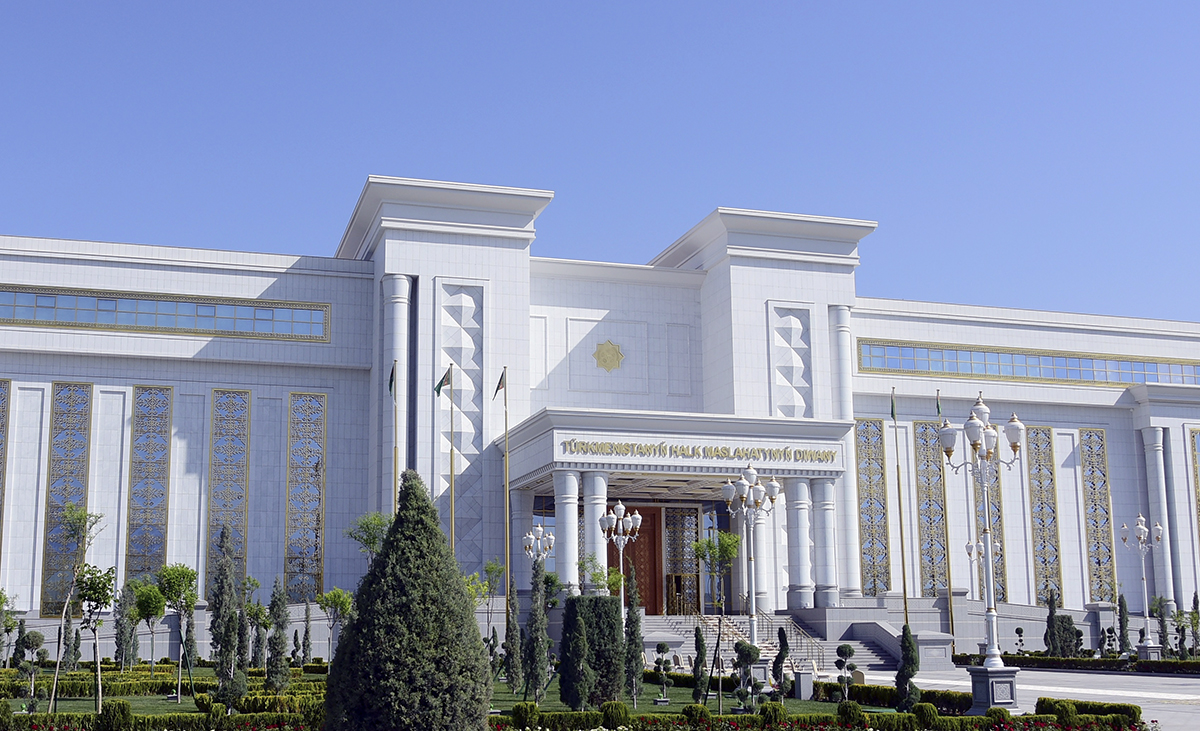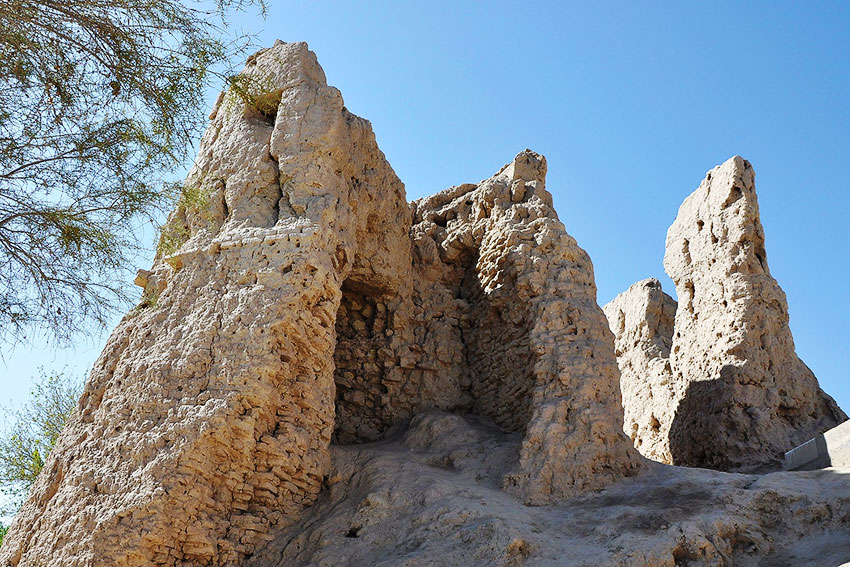The silk fabric keteni enjoys a great popularity not only with Turkmen nationals but also with numerous guests of our country who take with themselves all kinds of silk goods like scarves, cloaks, bags, and cuts from keteni thus expressing their unchangeable interest in the decorative and applied art and culture of the Turkmen nation. Today in the age of technological progress, national traditions continue to live in the Turkmen nation. Similarly, like many years ago today the jeweller’s art, fine art of weaving, and carpet making and embroidery are passed on from fathers to sons, from mothers to daughters creating professional dynasties. And the importance of ancient national traditions in the modern time is a reflection of a continued link of the past with the present and future.

…Soffits were lit brightly, strings of the dutar sounded and at the podium of the Fashion House of Ashgabat there appear girls in luminous dresses made on the motif of traditional Turkmen costume from silk fabric keteni. The music is combined with silver sounds of jewelleries –unchangeable accessories of the national women apparel. The collections from keteni are always the most desired ones of the models of the Fashion House, indeed when one is dressed in silk shining with a wide array of colours and wears something massive but unusual fine silver jewellery articles she feels pride carrying a national image at the podium and applauds of spectators continue as the Turkmen costume is so colourful and unique.

Production of keteni continues for hundreds of years. Preserved from time immemorial this fabric today still remains to be in fashion. Paying respect for traditions Turkmen fashion designers create wonderful collections of wedding and evening apparels where ethnic motifs sound anew as well so grandiose and noble.
A silk thread has a triangle section and as prism reflects light which evokes fine array of light and glitter. Once silk fabric was very expensive and only well-provided wealthy people could afford it. And even today this “transparent as ice” and “light as clouds” fabric is considered an attribute of fine taste and elegance. Possibilities of the modern production facilities enable to manufacture various fabrics from silk in density and texture – from thin chiffon and silk organza to heavy DuPont, taffeta and silk brocade.

And if China is a native land of silk, then Turkmenistan is the homeland of homemade silk fabric keteni. From the olden days men and women wore clothes made from this fabric but if the clothes of men made from keteni were limited only to such cloaks «dons», then the female dresses included numerous shawls, cloaks, and dresses. Usually the fringes of keteni ar enveloped with golden lines, which upon sewing remain on the obverse side of the fabric featuring constructive lines of the dress. Earlier keteni was of two colours: green (green keteni) and red (red keteni). Red keteni was considered the most valuable one. From it people made wedding and festive apparels. Still bride should have at least 2-3 dresses from red keteni in her dowry. Today like the previous times, embossing of keteni remains prerogative of handwork. And any handwork this work is very painstaking and requires great patience and certain skills.
Up today, the technology of production of keteni has remained unchanged. Like hundreds of years ago, women sit at a weaving loom called «tara”, its length is 30-40 cm, which earlier determined the cut of the fabric. Or to be more exact, they ”sit on the loom” which is similar to a small ship but instead of sails on its “board “silk threads of different colours are drawn and with the skilful hands of the “captain “ they are turned into a durable fabric emitting various lights.

The raw rough silk fibres of ivory colour serve the main essence of the fabric and every thread of it is divided by still thinner 6 threads by the weavers. Then these yarns are boiled in hot soapy water for softening. Imagine how great patience it requires to untangle these threads again, to dye and to wind around bobbins. Moreover, upon dying threads since the time of our ancestors people have used only natural dyes. So, in order to obtain red colour which enjoys a great popularity with Turkmens , madder is used and for tints of blue the herbal dye nil and peels of pomegranate for obtaining warm brown and yellow tints , leaves and bark of nut , onion peels, and tea were used. Of course, now chemical dyes are also used but top priority is always given to natural herbal dues. For durability of dyes quartzes and for bleaching of the fabric, it is used ashes of coal.

When a long work of yarn preparation is aback, long silk threads are put on the loom, the warp is fixed …and a magic begins. Skilful hands of weavers work so quickly shuttles from one side to the other fixing them to the warp and like a wonderful butterfly comes out from a simple cocoon before your eyes a wonderful work of art comes into birth. Its technology differs with simplicity, subtlety and stable traditions. However, it is not a final. The newly woven fabric with a length of ten meters is put off the spindle and is given a marketable style. It is starched and keteni acquires special lustre and relatively firmness and even it seems that this silk cut clinks when taken into hands. Now one can make a business costume for a businesswoman and apparel for a bride or a wonderful dress for an evening party…

…Soffits were lit brightly, strings of the dutar sounded and at the podium of the Fashion House of Ashgabat there appear girls in luminous dresses made on the motif of traditional Turkmen costume from silk fabric keteni. The music is combined with silver sounds of jewelleries –unchangeable accessories of the national women apparel. The collections from keteni are always the most desired ones of the models of the Fashion House, indeed when one is dressed in silk shining with a wide array of colours and wears something massive but unusual fine silver jewellery articles she feels pride carrying a national image at the podium and applauds of spectators continue as the Turkmen costume is so colourful and unique.

Production of keteni continues for hundreds of years. Preserved from time immemorial this fabric today still remains to be in fashion. Paying respect for traditions Turkmen fashion designers create wonderful collections of wedding and evening apparels where ethnic motifs sound anew as well so grandiose and noble.
A silk thread has a triangle section and as prism reflects light which evokes fine array of light and glitter. Once silk fabric was very expensive and only well-provided wealthy people could afford it. And even today this “transparent as ice” and “light as clouds” fabric is considered an attribute of fine taste and elegance. Possibilities of the modern production facilities enable to manufacture various fabrics from silk in density and texture – from thin chiffon and silk organza to heavy DuPont, taffeta and silk brocade.

And if China is a native land of silk, then Turkmenistan is the homeland of homemade silk fabric keteni. From the olden days men and women wore clothes made from this fabric but if the clothes of men made from keteni were limited only to such cloaks «dons», then the female dresses included numerous shawls, cloaks, and dresses. Usually the fringes of keteni ar enveloped with golden lines, which upon sewing remain on the obverse side of the fabric featuring constructive lines of the dress. Earlier keteni was of two colours: green (green keteni) and red (red keteni). Red keteni was considered the most valuable one. From it people made wedding and festive apparels. Still bride should have at least 2-3 dresses from red keteni in her dowry. Today like the previous times, embossing of keteni remains prerogative of handwork. And any handwork this work is very painstaking and requires great patience and certain skills.
Up today, the technology of production of keteni has remained unchanged. Like hundreds of years ago, women sit at a weaving loom called «tara”, its length is 30-40 cm, which earlier determined the cut of the fabric. Or to be more exact, they ”sit on the loom” which is similar to a small ship but instead of sails on its “board “silk threads of different colours are drawn and with the skilful hands of the “captain “ they are turned into a durable fabric emitting various lights.

The raw rough silk fibres of ivory colour serve the main essence of the fabric and every thread of it is divided by still thinner 6 threads by the weavers. Then these yarns are boiled in hot soapy water for softening. Imagine how great patience it requires to untangle these threads again, to dye and to wind around bobbins. Moreover, upon dying threads since the time of our ancestors people have used only natural dyes. So, in order to obtain red colour which enjoys a great popularity with Turkmens , madder is used and for tints of blue the herbal dye nil and peels of pomegranate for obtaining warm brown and yellow tints , leaves and bark of nut , onion peels, and tea were used. Of course, now chemical dyes are also used but top priority is always given to natural herbal dues. For durability of dyes quartzes and for bleaching of the fabric, it is used ashes of coal.

When a long work of yarn preparation is aback, long silk threads are put on the loom, the warp is fixed …and a magic begins. Skilful hands of weavers work so quickly shuttles from one side to the other fixing them to the warp and like a wonderful butterfly comes out from a simple cocoon before your eyes a wonderful work of art comes into birth. Its technology differs with simplicity, subtlety and stable traditions. However, it is not a final. The newly woven fabric with a length of ten meters is put off the spindle and is given a marketable style. It is starched and keteni acquires special lustre and relatively firmness and even it seems that this silk cut clinks when taken into hands. Now one can make a business costume for a businesswoman and apparel for a bride or a wonderful dress for an evening party…






